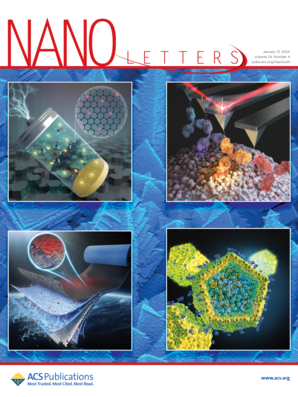降p带中心石墨表面的酮氧实现了硝基芳烃的高效无金属转移加氢
IF 9.6
1区 材料科学
Q1 CHEMISTRY, MULTIDISCIPLINARY
引用次数: 0
摘要
利用碳基纳米材料的关键挑战在于确定活性位点。在本文中,我们证明了石墨表面的酮氧是催化转移加氢(CTH)的活性位点,并提出了一种高效的纳米晶金刚石(ND)衍生碳基催化剂,用于将硝基苯转化为亚胺的无金属 CTH,硝基苯转化率达 99.9%,且具有独一无二的选择性(99.9%)。通过选择性地解构石墨表面或消除羰基,证实了石墨共轭羰基是催化活性位点。此外,动力学研究显示,苄醇的活化势垒低于硝基苯的活化势垒(分别为 88.8 kJ mol-1 和 119.1 kJ mol-1),这表明醇脱氢发生在硝基苯活化之前。密度泛函理论计算显示,sp2 杂化 C 表面上的酮氧下移 p 带中心可适度吸附苯甲醛中间产物,从而加速活性 H 的形成,用于接下来的氢化步骤,这也是该催化剂具有高催化活性的原因。本文章由计算机程序翻译,如有差异,请以英文原文为准。

Keto-Oxygen on Graphitic Surface with Downshifted p-Band Center Achieves Efficient Metal-Free Transfer Hydrogenation of Nitroarenes
The critical challenge in utilizing carbon-based nanomaterials is identifying the active site. Herein, we demonstrate the keto-oxygen on the graphitic surface as active sites for catalytic transfer hydrogenation (CTH) and present an efficient nanocrystalline diamond (ND)-derived carbon-based catalyst for metal-free CTH of nitroarenes to imine with 99.9% nitrobenzene conversion and exclusive selectivity (99.9%). By selectively deconstructing the graphitic surface or eliminating carbonyl groups, the graphite-conjugated carbonyl group is confirmed as the catalytically active site. Moreover, kinetic studies display the lower activation barrier of benzylalcohol than that of nitrobenzene (88.8 vs 119.1 kJ mol–1, respectively), indicating that alcohol dehydrogenation occurs prior to the activation of nitrobenzene. Density functional theory calculations reveal the downshifted p-band center of keto-oxygen on the sp2 hybrid C surface affords moderate adsorption of benzaldehyde intermediates, which accelerates the formation of active H for the following hydrogenation step and is responsible for the high catalytic activity.
求助全文
通过发布文献求助,成功后即可免费获取论文全文。
去求助
来源期刊

Nano Letters
工程技术-材料科学:综合
CiteScore
16.80
自引率
2.80%
发文量
1182
审稿时长
1.4 months
期刊介绍:
Nano Letters serves as a dynamic platform for promptly disseminating original results in fundamental, applied, and emerging research across all facets of nanoscience and nanotechnology. A pivotal criterion for inclusion within Nano Letters is the convergence of at least two different areas or disciplines, ensuring a rich interdisciplinary scope. The journal is dedicated to fostering exploration in diverse areas, including:
- Experimental and theoretical findings on physical, chemical, and biological phenomena at the nanoscale
- Synthesis, characterization, and processing of organic, inorganic, polymer, and hybrid nanomaterials through physical, chemical, and biological methodologies
- Modeling and simulation of synthetic, assembly, and interaction processes
- Realization of integrated nanostructures and nano-engineered devices exhibiting advanced performance
- Applications of nanoscale materials in living and environmental systems
Nano Letters is committed to advancing and showcasing groundbreaking research that intersects various domains, fostering innovation and collaboration in the ever-evolving field of nanoscience and nanotechnology.
 求助内容:
求助内容: 应助结果提醒方式:
应助结果提醒方式:


